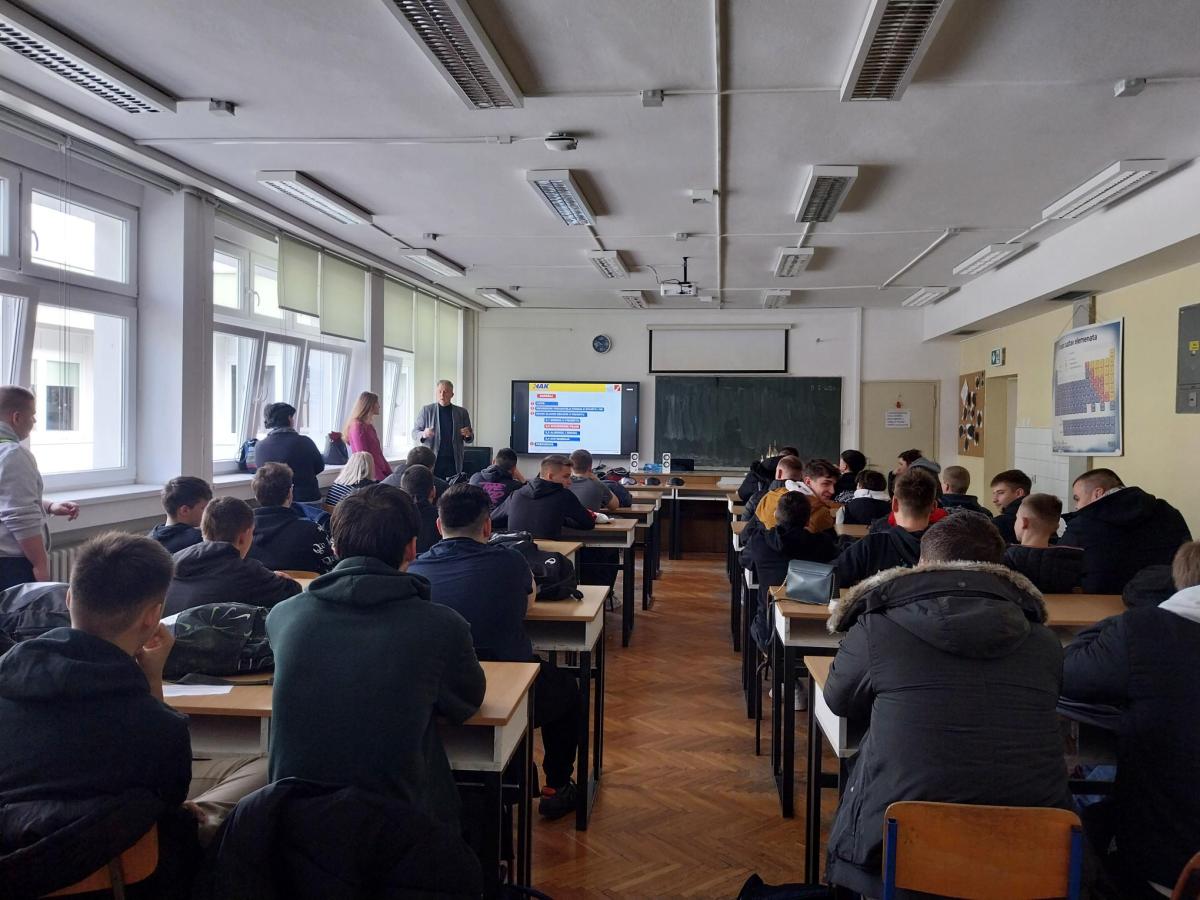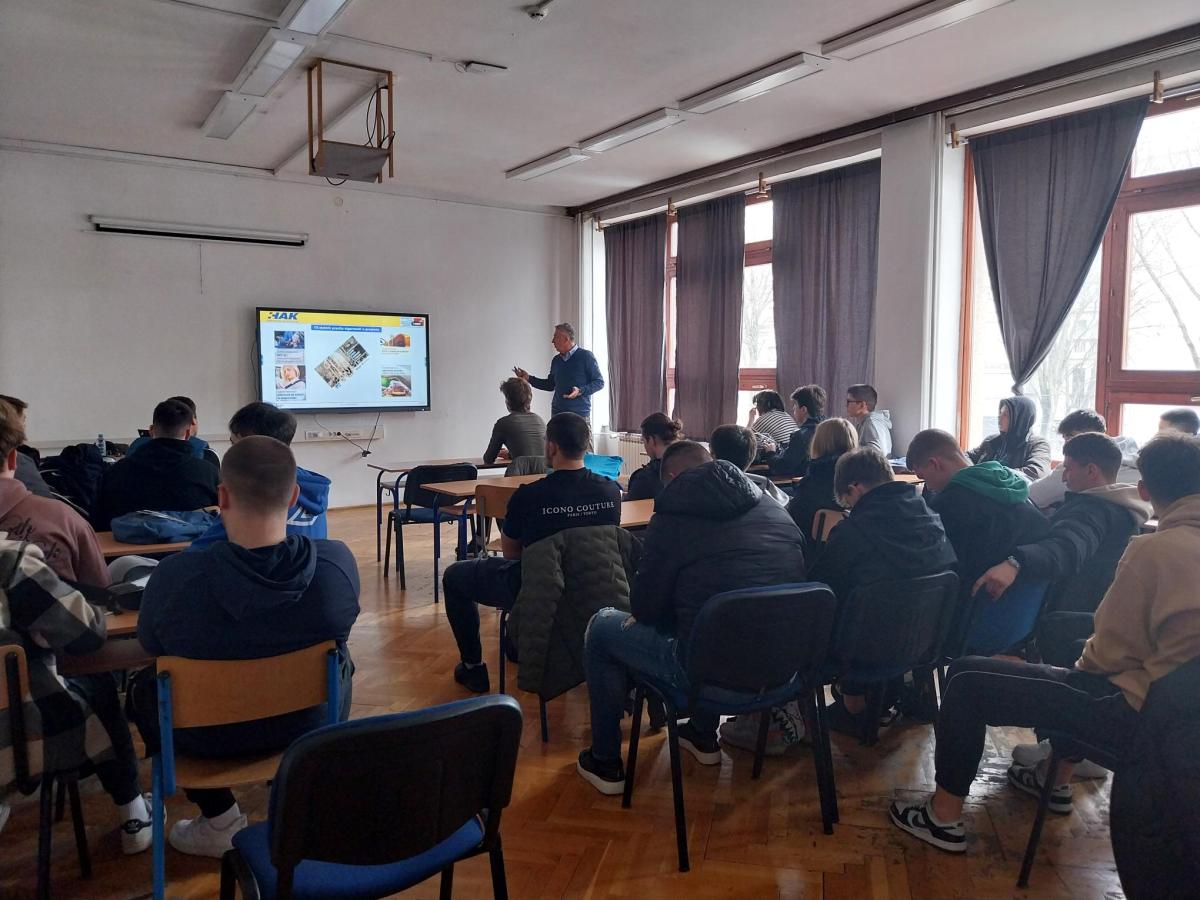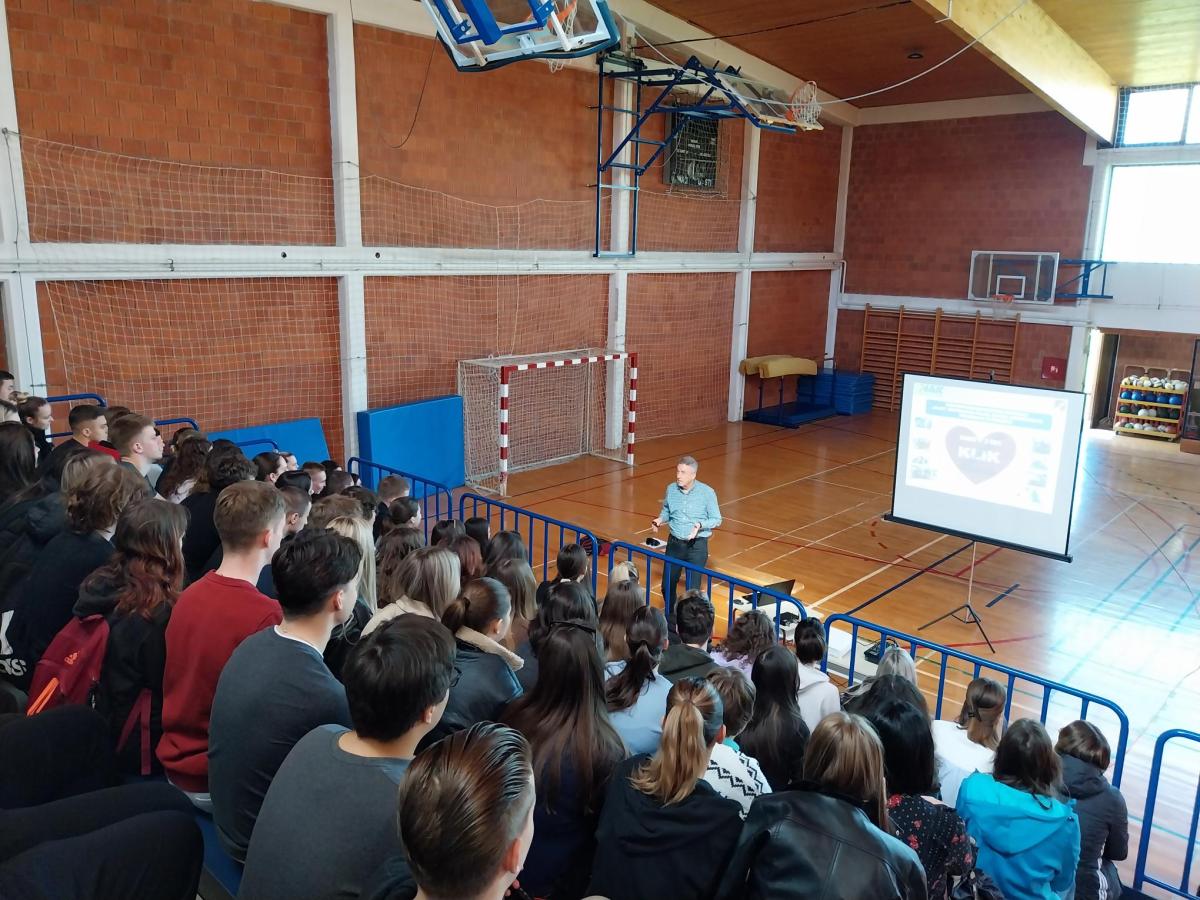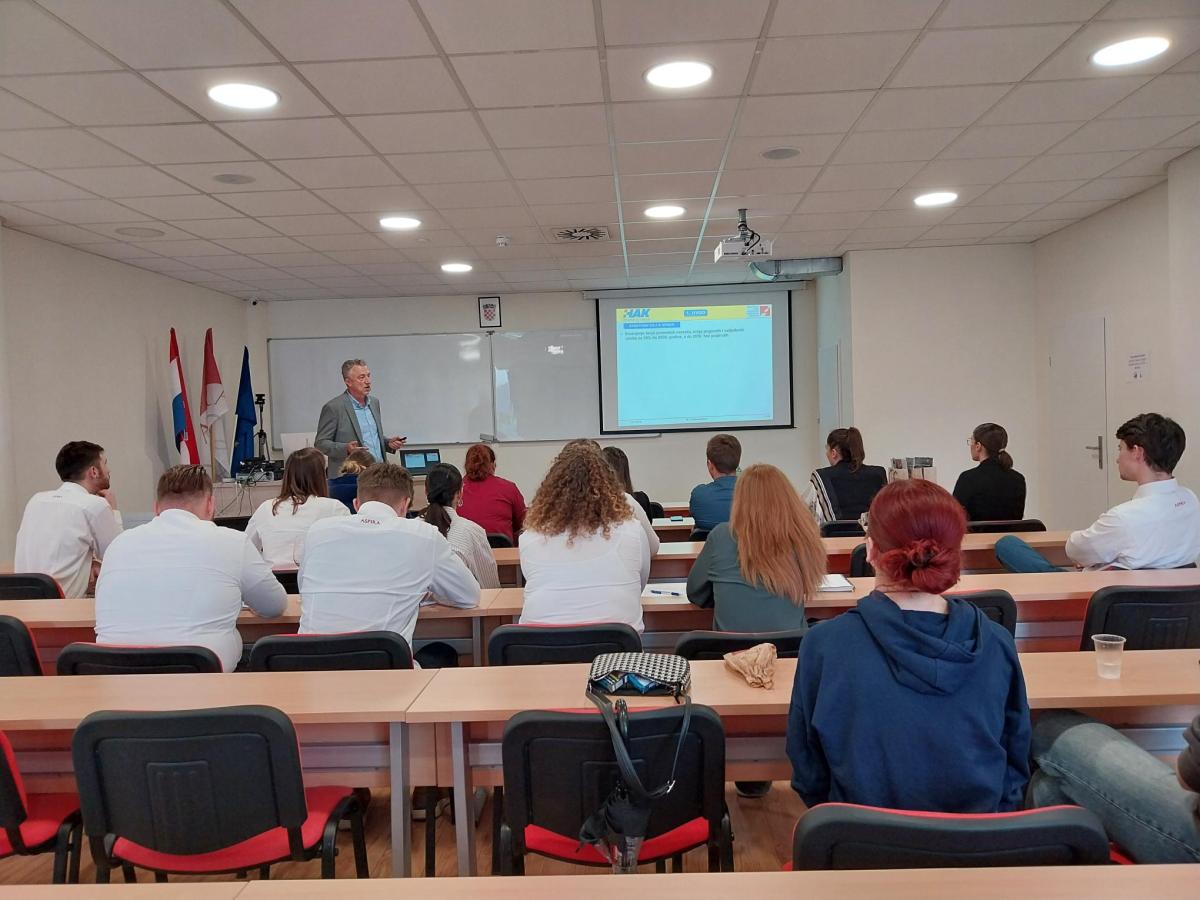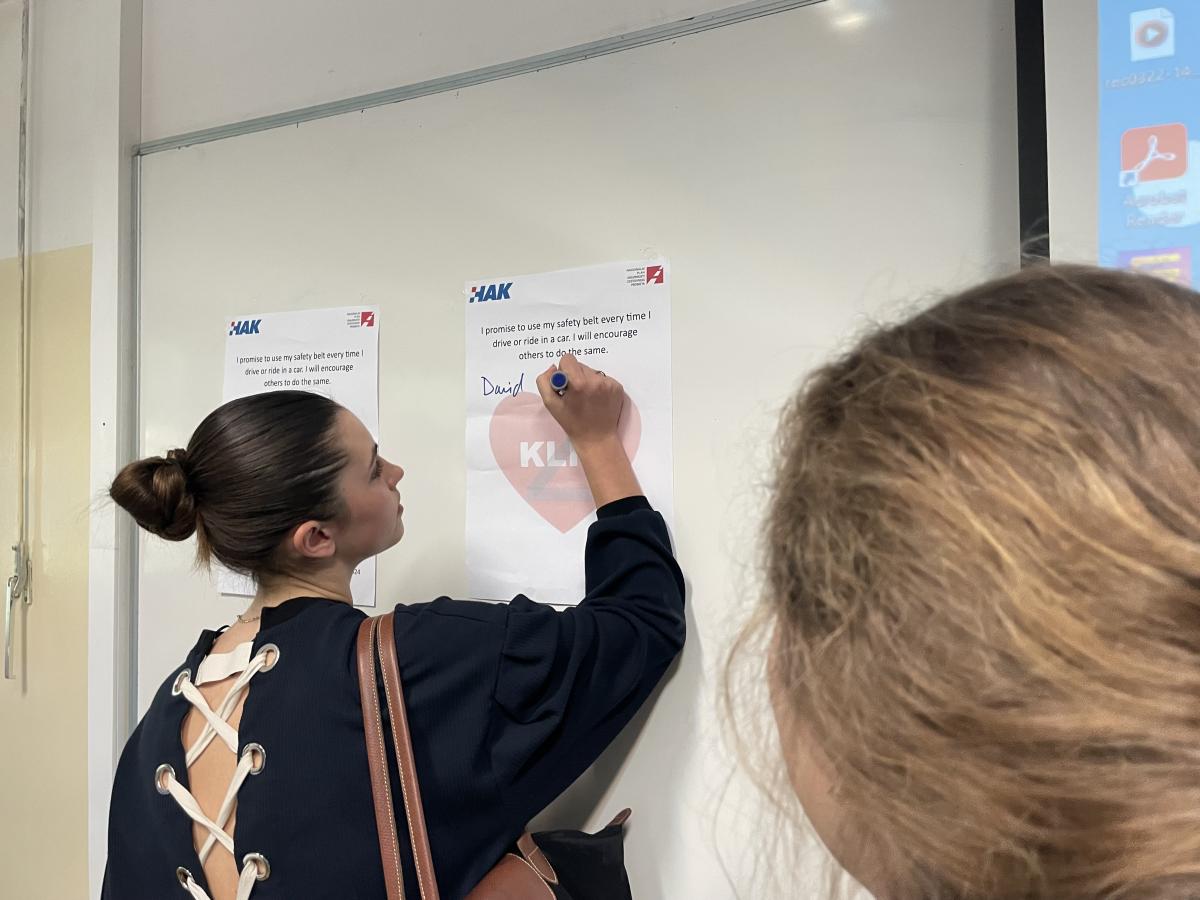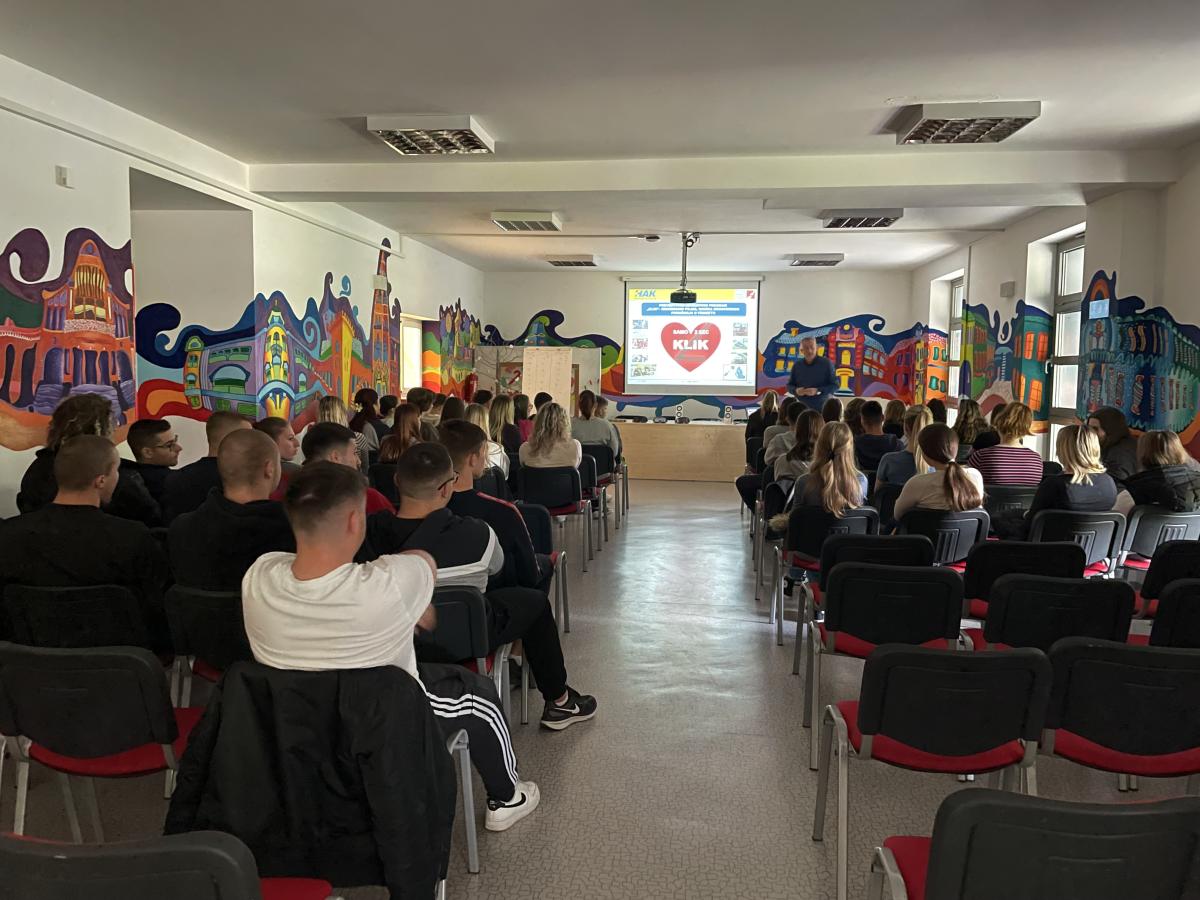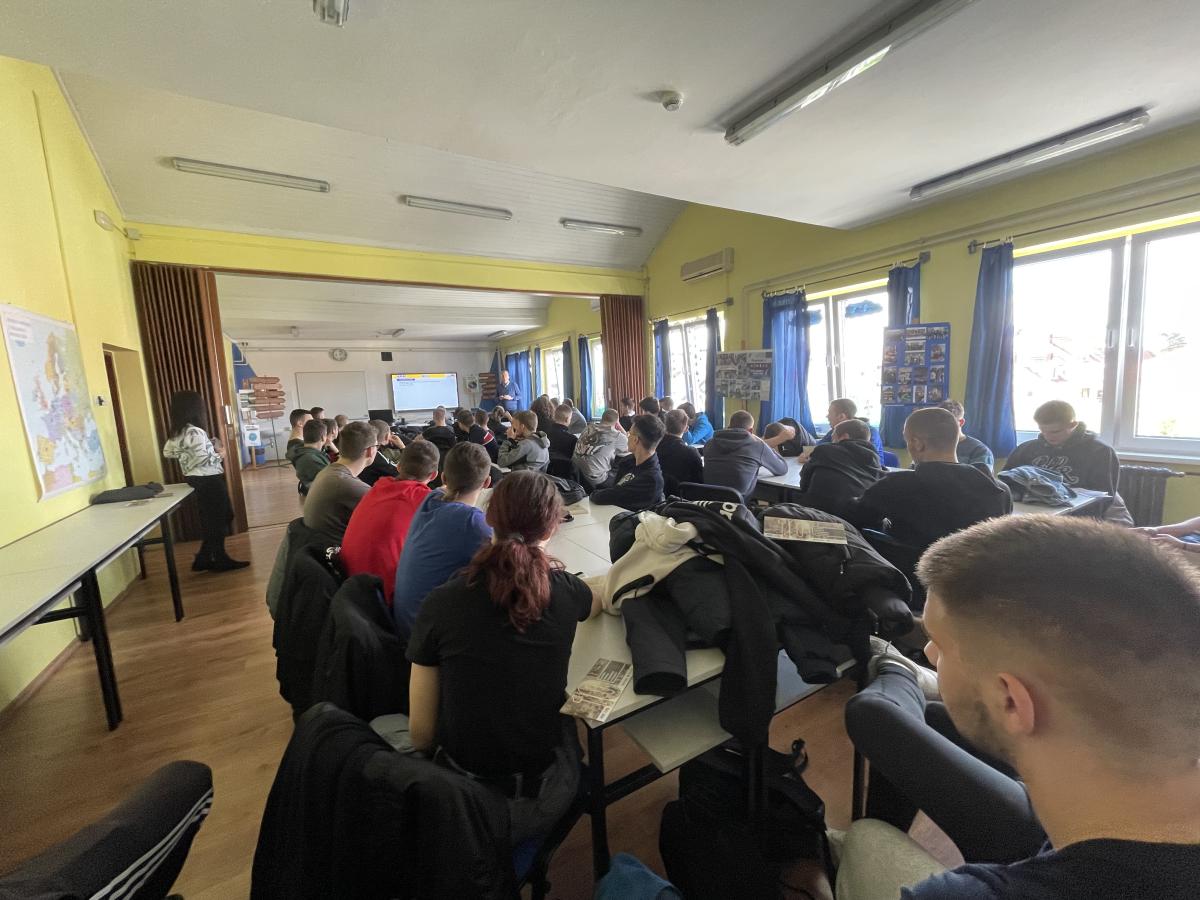Initiative details
Since 2017, the Croatian Automobile Club (HAK) has been implementing the educational and preventive program "KLIK - seat belt, a habit of responsible behavior" as part of the National Road Safety Plan of the Republic of Croatia, whose target group is senior high school students. The word “KLIK” is an acronym for “how to easily avoid a disaster” (in Croatian Kako Lako Izbjeći Katastrofu) and its pronunciation imitates the sound of buckling up.
Statistical data show that young people between the ages of 15 and 24 are one of the most vulnerable groups of road users in Croatia. In the Croatian National Road Safety Plan 2021-2030 it is visible that 28% of drivers who do not use seat belts are young drivers. This data significantly indicates the need for education of young people, which is done in the “KLIK” program.
We point out that in the Republic of Croatia, unlike the larger number of preschool and school children, the high school population has not yet been systematically covered by any projects within school curriculums in the field of road safety. This road safety program focuses on educating young people in order to achieve the Vision Zero, meaning our ultimate objective is to completely eliminate traffic fatalities and sever injuries on Croatian roads by 2050. It has been integrated into school curriculums, just like our other successful initiatives for elementary school students: “See and Click”, “Safe to School with HAK” and “Safe in Traffic”.
It is known that adolescents, in search of their identity and independence, are often inclined to disagree with adults and adopted rules of behavior under the pretext that their freedom is restricted. This life phase is characterized by the consolidation of knowledge and skills, the crystallization of attitudes and opinions and particularly rational mental maturation. The profile just described is one of the key reasons for risky behavior in traffic. The consequences are reflected in traffic accident statistics, where young people between the ages of 15 and 24 are one of the most vulnerable groups of road users. HAK conducts driving exams and the “KLIK” program is a perfect opportunity to reach young adults because of the need to address their values and behaviors prior to attending driving schools.
Statistical data show that young people between the ages of 15 and 24 are one of the most vulnerable groups of road users in Croatia. In the Croatian National Road Safety Plan 2021-2030 it is visible that 28% of drivers who do not use seat belts are young drivers. This data significantly indicates the need for education of young people, which is done in the “KLIK” program.
We point out that in the Republic of Croatia, unlike the larger number of preschool and school children, the high school population has not yet been systematically covered by any projects within school curriculums in the field of road safety. This road safety program focuses on educating young people in order to achieve the Vision Zero, meaning our ultimate objective is to completely eliminate traffic fatalities and sever injuries on Croatian roads by 2050. It has been integrated into school curriculums, just like our other successful initiatives for elementary school students: “See and Click”, “Safe to School with HAK” and “Safe in Traffic”.
It is known that adolescents, in search of their identity and independence, are often inclined to disagree with adults and adopted rules of behavior under the pretext that their freedom is restricted. This life phase is characterized by the consolidation of knowledge and skills, the crystallization of attitudes and opinions and particularly rational mental maturation. The profile just described is one of the key reasons for risky behavior in traffic. The consequences are reflected in traffic accident statistics, where young people between the ages of 15 and 24 are one of the most vulnerable groups of road users. HAK conducts driving exams and the “KLIK” program is a perfect opportunity to reach young adults because of the need to address their values and behaviors prior to attending driving schools.
Initiative date
Who was/is your target audience?
Young adults 17-25
Topic
Create awareness
Education in school or in community organizations
Knowledge building and sharing
Organisation details
Hrvatski autoklub (Croatian Automobile Club)
Association
Croatia
Zagreb
Contact name
Petra Vedriš
Telephone number
+385991697900
petra.vedris@hak.hr
Website link
Project activities
If you work together with external partners, list the most important partners and briefly describe their role.
HAK is implementing the “KLIK” program for the seventh year in a row so that the schools as users have previous experience and knowledge about the value of the project. Contact with them is direct or in cooperation with the Ministry of Interior, traffic police and automobile clubs that are part of our organization: AK Čakovec, AK Siget, AMK Križevci, AMK Oroslavje, AK Ploče, AK Dalmacija, AK Zadar, AK Rijeka, AK Pula-Rovinj, AK Pazin, AK Poreč, AK Nova Gradiška, AK Marsonija, AK Velika Gorica, AK Bregana, AK Koprivnica, AK Krk, AK Jastrebarsko i AK Bjelovar. Since the rollover simulator participates in the program, automobile clubs provide its transportation from our base to schools and back.
Based on the statistics showing that the Republic of Croatia is one of the most unsafe European countries in road traffic, HAK added the "10 Golden Rules" contest to the program, which was accepted and awarded by The Fédération Internationale de l'Automobile (FIA). The best videos get chosen by representatives of HRT, Academy of Dramatic Arts, Ministry of Internal Affairs, Croatian Film Association and production company Digimark Ltd.
The implementation of the program is followed by the media at the local, regional and national level (Internet sites, press, radio and TV stations). The project directly affects the behavior of individuals in traffic by broadcasting preventive-educational videos on the HRT "Traffic Info" show and also as a part of the “HAK – Traffic Education” show.
Based on the statistics showing that the Republic of Croatia is one of the most unsafe European countries in road traffic, HAK added the "10 Golden Rules" contest to the program, which was accepted and awarded by The Fédération Internationale de l'Automobile (FIA). The best videos get chosen by representatives of HRT, Academy of Dramatic Arts, Ministry of Internal Affairs, Croatian Film Association and production company Digimark Ltd.
The implementation of the program is followed by the media at the local, regional and national level (Internet sites, press, radio and TV stations). The project directly affects the behavior of individuals in traffic by broadcasting preventive-educational videos on the HRT "Traffic Info" show and also as a part of the “HAK – Traffic Education” show.
Please describe the project activities you carried/are carrying out and the time period over which these were implemented.
Experts from the Road Safety Office explain to students the meaning and usefulness of safety belts in traffic during one school hour as part of an interactive lesson. Using life examples and stories, they explain how wearing a seat belt in a vehicle is not only a legal obligation for drivers and passengers, but also an element of general and personal culture. In addition, emphasis is placed on all other factors that increase the risk of traffic accidents. In the second lesson, a rollover simulator is a tool used to demonstrate the critical importance of wearing seat belts in vehicles. It involves a vehicle that is designed to rollover, allowing participants to experience the forces and consequences of not wearing a seat belt. This visual demonstration helps illustrate the potential difference between life and death in the event of a crash. The simulator helps to emphasize the role that the drivers and passengers play in ensuring everyone in a vehicle is safe and secure, which is crucial for achieving the Vision Zero. During the implementation of the program, each student receives a leaflet about “10 Golden Rules” (FIA).
Additionally, as part of the program, there is a contest for production of short films on the topic of road safety named “10 Golden Rules”. Young people up to the age of 24 in 2024 created 54 short videos. 3 films were awarded and they are used for preventive and educational purposes in the television show "Traffic Info" on the Croatian Radio and Television (HRT) throughout the year. HAK publicly broadcasts those videos as messages about responsible traffic behavior 3-4 times a day in the show "Traffic Info" on HRT Channels 1 and 4. HAK created the contest on the topic of “10 Golden Rules” in traffic in order to raise awareness of all traffic participants. The program is free of charge for schools/participants.
Additionally, as part of the program, there is a contest for production of short films on the topic of road safety named “10 Golden Rules”. Young people up to the age of 24 in 2024 created 54 short videos. 3 films were awarded and they are used for preventive and educational purposes in the television show "Traffic Info" on the Croatian Radio and Television (HRT) throughout the year. HAK publicly broadcasts those videos as messages about responsible traffic behavior 3-4 times a day in the show "Traffic Info" on HRT Channels 1 and 4. HAK created the contest on the topic of “10 Golden Rules” in traffic in order to raise awareness of all traffic participants. The program is free of charge for schools/participants.
In terms of implementation, what worked well and what challenges did you need to overcome?
The implementation of our program has been a resounding success, with continuous interest from schools. Real-life examples from the interactive presentation and simulator's ability to engage students and provide a realistic experience have been instrumental in driving this interest. We have been able to update the presentations with new and relevant data about road safety, ensuring that the experience remains fresh and impactful for each new generation of students.
One of the key challenges we have faced is the difficulty in transporting the simulator to some schools due to its size. Specifically, the simulator cannot be transported to islands by ferry due to its dimensions and the height from the ground to the trailer. To overcome this, we have had to get creative and find alternative solutions. For instance, we have invited students from schools without suitable yards or playgrounds to experience the simulator at public events, ensuring that no student is left out.
Our project, due to its constraints, is able to cover approximately 6,000 to 7,000 students of a total of 35,000 students in a generation. Although we are not able to reach all students, we consistently maintain a presence in schools in all 20 Croatian counties.
Despite these challenges, the project has been well-received by schools and has become a staple in many educational institutions. The simulator's ability to provide a hands-on and immersive experience has been particularly effective in engaging students and helping them develop a deeper understanding of road safety. As a result, we have seen a significant increase in bookings, with many schools booking our visit several months in advance.
One of the key challenges we have faced is the difficulty in transporting the simulator to some schools due to its size. Specifically, the simulator cannot be transported to islands by ferry due to its dimensions and the height from the ground to the trailer. To overcome this, we have had to get creative and find alternative solutions. For instance, we have invited students from schools without suitable yards or playgrounds to experience the simulator at public events, ensuring that no student is left out.
Our project, due to its constraints, is able to cover approximately 6,000 to 7,000 students of a total of 35,000 students in a generation. Although we are not able to reach all students, we consistently maintain a presence in schools in all 20 Croatian counties.
Despite these challenges, the project has been well-received by schools and has become a staple in many educational institutions. The simulator's ability to provide a hands-on and immersive experience has been particularly effective in engaging students and helping them develop a deeper understanding of road safety. As a result, we have seen a significant increase in bookings, with many schools booking our visit several months in advance.
Evaluation
Please summarise how you have evaluated the initiative’s impact (e.g. social media reach, survey, feedback forms, statistics).
The evaluation of our initiative’s impact has been crucial in understanding its effectiveness. One of the key components of the evaluation was the collection of feedback from students and school staff through interviews. Those interviews provided valuable insights into how the initiative impacted the participants and offered guidelines for increasing student involvement in the topic. Many students reported that the initiative helped them develop a greater awareness of the importance of road safety and measures they could take to protect themselves and others. In terms of school staff and students’ feedback, the project’s popularity can be attributed to its constant engagement with schools and its full schedule. The new addition to our project from this year is an exit card, meaning that at the end of the interactive lesson students make and sign a commitment to themselves to always wear a seat belt. They sign a promise to ensure their own safety and the safety of others.
The program maintains statistics on the number of lessons, schools, cities and participants, which indicates its growing reach and impact. For example, the project covered 68 schools in 2022, 89 schools in 2023 and 42 schools so far this year, indicating a steady increase in its scope and influence. New schools are constantly contacting us to include them to our schedule.
For the above-mentioned reasons, we expect that in 2024 we will surpass the number of covered schools from the previous year.
The program maintains statistics on the number of lessons, schools, cities and participants, which indicates its growing reach and impact. For example, the project covered 68 schools in 2022, 89 schools in 2023 and 42 schools so far this year, indicating a steady increase in its scope and influence. New schools are constantly contacting us to include them to our schedule.
For the above-mentioned reasons, we expect that in 2024 we will surpass the number of covered schools from the previous year.
What has been the effect of the activities?
In 2023 the interactive, educational lesson was attended by 6,157 students in 89 high schools. The program was implemented in 49 cities in all 20 Croatian counties. In 2024, so far, 4,295 students participated in the program in 42 high schools in 28 cities. From this year on, it is possible to attend the education in English. By reaching a large number of students nationwide, the project effectively disseminated crucial road safety information and fostered a culture of responsible driving behavior.
The road safety education project that reaches students nationwide had a significant positive impact on road safety, particularly in enhancing seat belt usage and reducing accidents. The project's effectiveness was evaluated through various measures, including observing a decrease in the number of accidents caused by young drivers. The project's success in promoting seat belt use was notable, complementing other traffic prevention initiatives.
Positive feedback from schools and students made our project part of school curriculums and we get invited every year by schools to educate their new generation of senior students, but they also spread the word about the value of “KLIK” to other schools and communities.
Notably, the road safety education project complemented other traffic prevention actions by reinforcing the importance of seat belt usage as a fundamental safety measure. By integrating seat belt education into broader traffic safety initiatives, the project created a comprehensive approach to enhancing road safety and reducing accidents on the roads.
The number of road fatalities in Croatia has been in continuous decline since 2013. In 2013, there were 62 young drivers involved in traffic accidents, which decreased to 36 in 2022. This decline is a testament to the effectiveness of road safety measures and education which results in a decrease in risky driving behaviors among young drivers.
The road safety education project that reaches students nationwide had a significant positive impact on road safety, particularly in enhancing seat belt usage and reducing accidents. The project's effectiveness was evaluated through various measures, including observing a decrease in the number of accidents caused by young drivers. The project's success in promoting seat belt use was notable, complementing other traffic prevention initiatives.
Positive feedback from schools and students made our project part of school curriculums and we get invited every year by schools to educate their new generation of senior students, but they also spread the word about the value of “KLIK” to other schools and communities.
Notably, the road safety education project complemented other traffic prevention actions by reinforcing the importance of seat belt usage as a fundamental safety measure. By integrating seat belt education into broader traffic safety initiatives, the project created a comprehensive approach to enhancing road safety and reducing accidents on the roads.
The number of road fatalities in Croatia has been in continuous decline since 2013. In 2013, there were 62 young drivers involved in traffic accidents, which decreased to 36 in 2022. This decline is a testament to the effectiveness of road safety measures and education which results in a decrease in risky driving behaviors among young drivers.
Please briefly explain why your initiative is a good example of improving road safety.
Seat belt education among young drivers and the use of our rollover simulator is a crucial component of educating young adults since they are likely to engage in risky driving behaviors, such as not wearing seat belts, which significantly increases their risk of fatal injury or death in the event of a crash. According to our online survey, only around 70% drivers wear a seat belt, while it is only 11,90% of passengers in the back seat, which is making our initiative essential to emphasize the importance of seat belt use to young people.
The rollover simulator is an effective tool in conveying dangers of not wearing seat belts because it provides a visceral and memorable experience for young drivers. By witnessing the devastating effects of a crash without seat belts, young drivers are more likely to internalize the importance of wearing seat belts and adopt safer driving habits. By integrating seat belt educations and a rollover simulator into education of young people, we engage students not only cognitively, but also offer them a personal experience that can potentially significantly reduce the number of fatalities and injuries on our roads, ultimately improving road safety for all.
The key potential of the project lies in the young population, who should take on the role of ambassadors and convey the acquired experiences and elaborated attitudes to other road users with whom they are in daily contact, friends, acquaintances, parents, etc. Students will use the acquired communication skills to promote responsible behavior in horizontal sense (transmission of information to other students) and in a vertical sense (influence on possibly irresponsible drivers in their families).
The rollover simulator is an effective tool in conveying dangers of not wearing seat belts because it provides a visceral and memorable experience for young drivers. By witnessing the devastating effects of a crash without seat belts, young drivers are more likely to internalize the importance of wearing seat belts and adopt safer driving habits. By integrating seat belt educations and a rollover simulator into education of young people, we engage students not only cognitively, but also offer them a personal experience that can potentially significantly reduce the number of fatalities and injuries on our roads, ultimately improving road safety for all.
The key potential of the project lies in the young population, who should take on the role of ambassadors and convey the acquired experiences and elaborated attitudes to other road users with whom they are in daily contact, friends, acquaintances, parents, etc. Students will use the acquired communication skills to promote responsible behavior in horizontal sense (transmission of information to other students) and in a vertical sense (influence on possibly irresponsible drivers in their families).
How have you shared information about your project and its results?
The implementation of the project is monitored by the media at the local, regional and national level (Internet sites, press, radio and TV stations). The project directly affects the behavior of individuals in traffic by broadcasting preventive and educational videos in the HRT shows "Traffic Info" and “HAK – Traffic Education”. In the following video, it is possible to see an episode from the “HAK – Traffic Education” program on how our project is being implemented both in Croatian and English at the at the XV Grammar School in Zagreb.
https://www.youtube.com/watch?v=Glmn4UsploU
All schools are posting information about the project on their own websites. Posts about “KLIK” are available also on the FIA and ERSC websites to reach the international community. All of this allows the project to be widely publicized and accessible to not only to wider audience.
At our organization we believe in the power of community engagement. To this end, we organize events that not only promote the project, but also recognize and celebrate the achievements of individuals who share our vision. One of our most exciting events is the annual “10 Golden Rules” Awards. The winners are awarded prizes and we inspire them to continue making a difference in their communities. In addition to that, we organize an expert meeting that brings together other institutions that promote road safety in Croatia.
You can find some examples below:
https://members.fiaregion1.com/rssfeeds/hak-awards-videos-on-the-topic-10-golden-rules-for-road-safety/
https://www.baranjainfo.hr/preventivni-projekt-klik-odrzan-u-belom-manastiru/
https://www.radionasice.hr/preventivno-edukativni-program-klik/
https://ss-valpovo.hr/preventivno-edukativni-program-klik-navika-odgovornog-ponasanja/
https://www.ss-ivanec.hr/dogadanja/2206-odrzana-hak-ova-edukacija-klik-navika-odgovornog-ponasanja-u-prometu
https://www.veleri.hr/hr/vijesti/na-veleucilistu-u-rijeci-odrzana-preventivno-edukativna-akcija-pod-nazivom-klik-navika
https://www.ak-rijeka.hr/10-zlatnih-pravila-u-prometu-hak-natjecaj-2024/
https://npscp.hr/vijesti/hak-dodijelio-nagrade-za-izradu-videospota-na-temu-10-zlatnih-pravila
https://x.com/mojzagrebinfo/status/1799087793370452105
https://www.hak.hr/sigurnost-u-prometu/prometna-preventiva/klik/
https://www.hak.hr/vijest/2261/hak-dodijelio-nagrade-za%20izradu-videospota-na-temu-10-zlatnih-pravila-2024
https://www.youtube.com/watch?v=Glmn4UsploU
All schools are posting information about the project on their own websites. Posts about “KLIK” are available also on the FIA and ERSC websites to reach the international community. All of this allows the project to be widely publicized and accessible to not only to wider audience.
At our organization we believe in the power of community engagement. To this end, we organize events that not only promote the project, but also recognize and celebrate the achievements of individuals who share our vision. One of our most exciting events is the annual “10 Golden Rules” Awards. The winners are awarded prizes and we inspire them to continue making a difference in their communities. In addition to that, we organize an expert meeting that brings together other institutions that promote road safety in Croatia.
You can find some examples below:
https://members.fiaregion1.com/rssfeeds/hak-awards-videos-on-the-topic-10-golden-rules-for-road-safety/
https://www.baranjainfo.hr/preventivni-projekt-klik-odrzan-u-belom-manastiru/
https://www.radionasice.hr/preventivno-edukativni-program-klik/
https://ss-valpovo.hr/preventivno-edukativni-program-klik-navika-odgovornog-ponasanja/
https://www.ss-ivanec.hr/dogadanja/2206-odrzana-hak-ova-edukacija-klik-navika-odgovornog-ponasanja-u-prometu
https://www.veleri.hr/hr/vijesti/na-veleucilistu-u-rijeci-odrzana-preventivno-edukativna-akcija-pod-nazivom-klik-navika
https://www.ak-rijeka.hr/10-zlatnih-pravila-u-prometu-hak-natjecaj-2024/
https://npscp.hr/vijesti/hak-dodijelio-nagrade-za-izradu-videospota-na-temu-10-zlatnih-pravila
https://x.com/mojzagrebinfo/status/1799087793370452105
https://www.hak.hr/sigurnost-u-prometu/prometna-preventiva/klik/
https://www.hak.hr/vijest/2261/hak-dodijelio-nagrade-za%20izradu-videospota-na-temu-10-zlatnih-pravila-2024
Supporting materials
